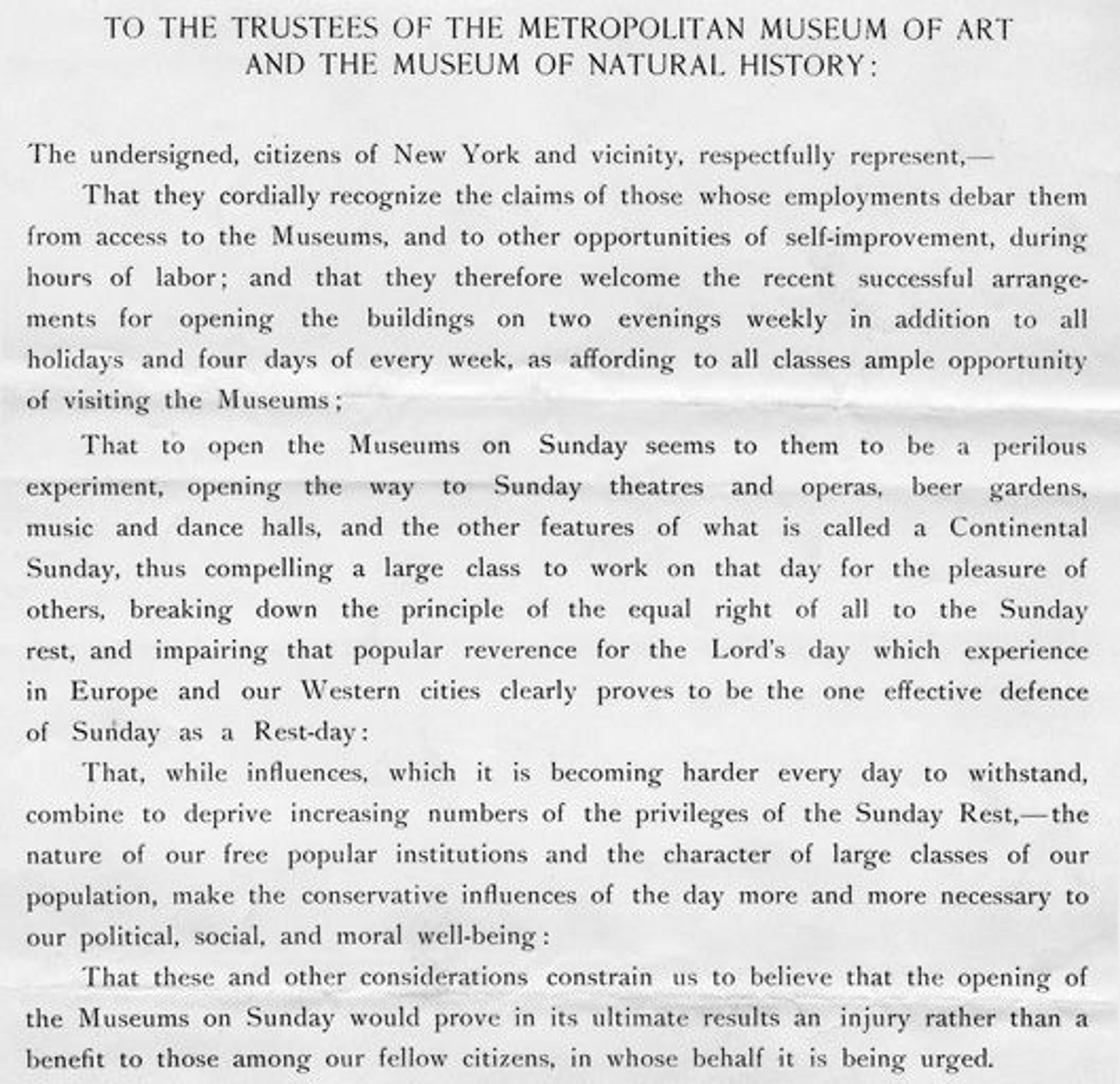Today in Met History: May 31
«One hundred and twenty years ago today, on May 31, 1891, The Metropolitan Museum of Art opened to the public on a Sunday for the first time in its history. The decision to allow Sunday admission followed nearly twenty years of debate on the subject.»
Dating back to the colonial period, Sunday closing laws (also known as "Sabbath laws" or "blue laws") forbade work and various other activities on Sundays. The forbidden activities differed from place to place and were frequently debated; they could include buying, selling, traveling, public entertainment, and sports. According to historian Craig Harline, this issue "was the longest of all national debates during the nineteenth century, preceding and outlasting even more heated debates over temperance and slavery."[1]
Winifred E. Howe examines the Sunday admission controversy at the Museum in A History of The Metropolitan Museum of Art (1913). As early as 1871, one year after the Museum's founding, some fundraising materials included the following pledge: "It is not the intention of the promoters of The Metropolitan Museum of Art ever to open the same on Sundays as a place of amusement. It is distinctly understood that your subscription . . . is made on that condition."[2]
Shortly after the Museum opened its first building at its current Central Park location in 1880, Trustee Joseph H. Choate made a motion for the Museum to open to the public on Sundays, but the Board tabled his proposal. In 1881, the New York City Department of Public Parks received a petition signed by over ten thousand citizens requesting that The Metropolitan Museum of Art and American Museum of Natural History open on Sundays. However, Trustees at both museums were hesitant to comply; such a controversial move might cost them political support or funding. The debate continued as more petitions, arguing both sides of the issue, followed.

Statement of purpose for a petition in favor of Sunday opening (1881)

Statement of purpose for a petition against Sunday opening (ca. 1885)
In 1885, the Department of Public Parks directed the Museum to open on Sundays, threatening to cut its funding if the Met did not comply. In an effort to appease the Parks Department and in response to growing public support for Sunday admission, the Museum offered evening hours on Tuesdays and Saturdays, made possible by the installation of electric lights. However, the expanded hours did little to satisfy the proponents of Sunday admission. At the time, the Met's peer institutions were slowly starting to acquiesce to the same demands; the Museum of Fine Arts, Boston and Cincinnati Museum agreed to open on Sundays, and "the British Museum opened on Sunday afternoons."[3]
Finally, after years of consideration and debate, the Museum's Trustees voted and passed a resolution on May 18, 1891: "That until the further order of the Board the Museum be opened free to the public every Sunday from one P.M. until a half hour before sunset." Though the vote was not unanimous, the tide had turned; twelve Trustees voted in favor of Sunday opening, five were against, and one abstained. Two Sundays later, on May 31, the Museum was open to the public.
Today, thousands of visitors pass though the Museum's doors on Sundays to enjoy its collections and wide variety of tours and programs.
Melissa Bowling is assistant archivist in the Museum Archives.
Related Links
Google timeline of Sunday laws
Information about "Sabbath law" in the New York State Legislature online database
Notes
[1] Harline, Craig, Sunday: A History of the First Day from Babylonia to the Super Bowl (New York: Doubleday, 2007).
[2] Howe, Winifred E., A History of The Metropolitan Museum of Art. (New York: The Metropolitan Museum of Art, 1913), p. 236–38.
[3] Miller, Stephen, The Peculiar Life of Sundays (Cambridge, MA: Harvard University Press, 2008), p. 168.
Melissa Bowling
Melissa Bowling is the associate archivist in the Museum Archives.